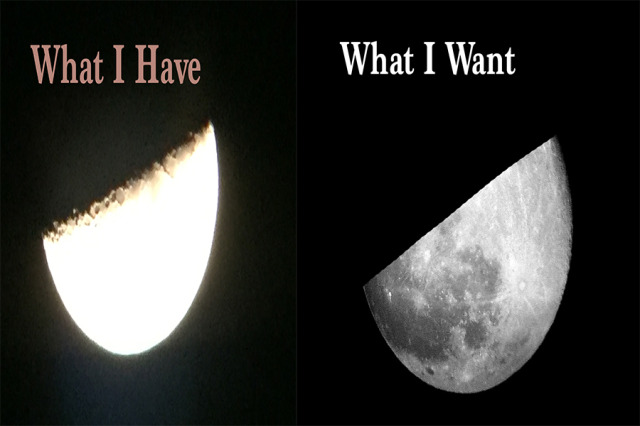How to filter out the brightness of the moon in iPhone? Read more please?
I have purchased one these little telescope that can be attached to my iPhone 6. You can see real far with it, without attaching it to the iPhone i can look through the telescope and actually see the surface of the moon but when i attach to the iPhone and target moon, the glowing brightness of the moon doesn't allow for the image to focus on the detail of the surface, how can i add some filter bring down the brightness of the moon on my phone if there's anyway at all. 
I have purchased one these little telescope that can be attached to my iPhone 6. You can see real far with it, without attaching it to the iPhone i can look through the telescope and actually see the surface of the moon but when i attach to the iPhone and target moon, the glowing brightness of the moon doesn't allow for the image to focus on the detail of the surface, how can i add some filter bring down the brightness of the moon on my phone if there's anyway at all. Depends on your type of telescope.
I will describe the trick for a "reflecting telescope" (a telescope with a mirror at the bottom of a tube). I made a mask from a piece of black cardboard, so that it fits on the opening of the telescope (at the front). By itself, this mask blocks all light entering the telescope.
Then I make a circular hole (smaller than the opening of the telescope) in the mask: in this way, there's a lot less light entering the telescope.
If the hole is round WITH CLEAN EDGES (that is the most important part), it will not add interference with the image (however, it will make the image less detailed, as if you had a smaller telescope).
The magnification will sty the same, but the image will be made from less light = the image will be less bright.
If you try with more than one piece of cardboard, with different sized holes, you will find a combination that works well.
If you have lots of cardboard (and LOTS of patience), you can try different shapes and sizes for the hole.
The trick should work the same for a refracting telescope (one with a lens at the front). In both cases, the cardboard must be made so that it sits in front of the telescope without falling off (I made an edge by adding a strip of cardboard, with scotch tape, to make the cardboard disk look like a cake pan).
With a refractor telescope, you have the added concern of being able to install and remove the mask without your fingers touching the lens. Buy a super zoom camera, or a DSLR. Trial and error.
Try to take a photo in the day time using the telescope.
Then start varying things to see what works.
I'm thinking it is only meant for daytime photography.
bird watching etc
(which includes that bird who lives across the street in number 28. Use a moon filter or polarizing filter.
You would do better with a Celestron C11 and a Nikon.
Buy a super zoom camera, or a DSLR.
Trial and error.
Try to take a photo in the day time using the telescope.
Then start varying things to see what works.
I'm thinking it is only meant for daytime photography.
bird watching etc
(which includes that bird who lives across the street in number 28.
Use a moon filter or polarizing filter.
You would do better with a Celestron C11 and a Nikon.
- Why do my pictures of the moon turn out rubbish? I have an iphone which I take most my pictures of, but it turns out so RUBBISH with the cameras I use why?
- What counts as data on Verizon's data plans with the iphone? Read more please? So i got an iphone for xmas and i have a 2gig plan, so what counts as data on the phone? Like playing games, emails, tweets, ect? Also when the bill comes in will it show, say i downloaded the twitter app, will it show that i spend time on it? (my dad doesn't know i have one so trying to make sure he doesn't find out.) Any help would be very helpful! Please and thank you!
- Is tbere any major différence between thé iPhone 6 and the 6s? Whooppeee is Xmas again and my daughter wants new 2nd hand) iPhone… 2 years ago almost bought her 5 before i réaliséd that it was 5s she wanted ( cos thé 5 sucks?) And I don't want to screw up this year…
- Iphone 5s charge running out vey fast after 2 says of buy, brightness is 20% and? I went to app forums and folowed several links to save charge but still not much improments http://www.everythingicafe.com/forum/threads/iphone-5s-questions-and-issues.104931/page-4